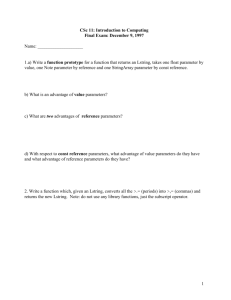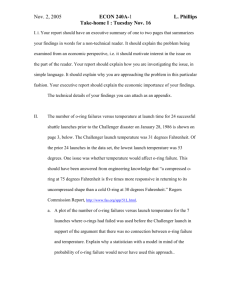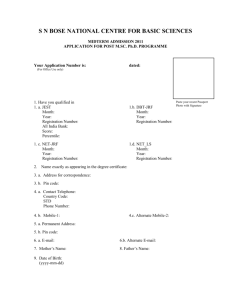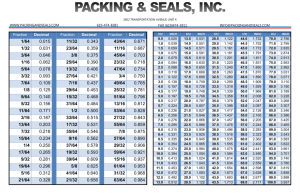Static Pins for Cavity Pressure Applications
advertisement
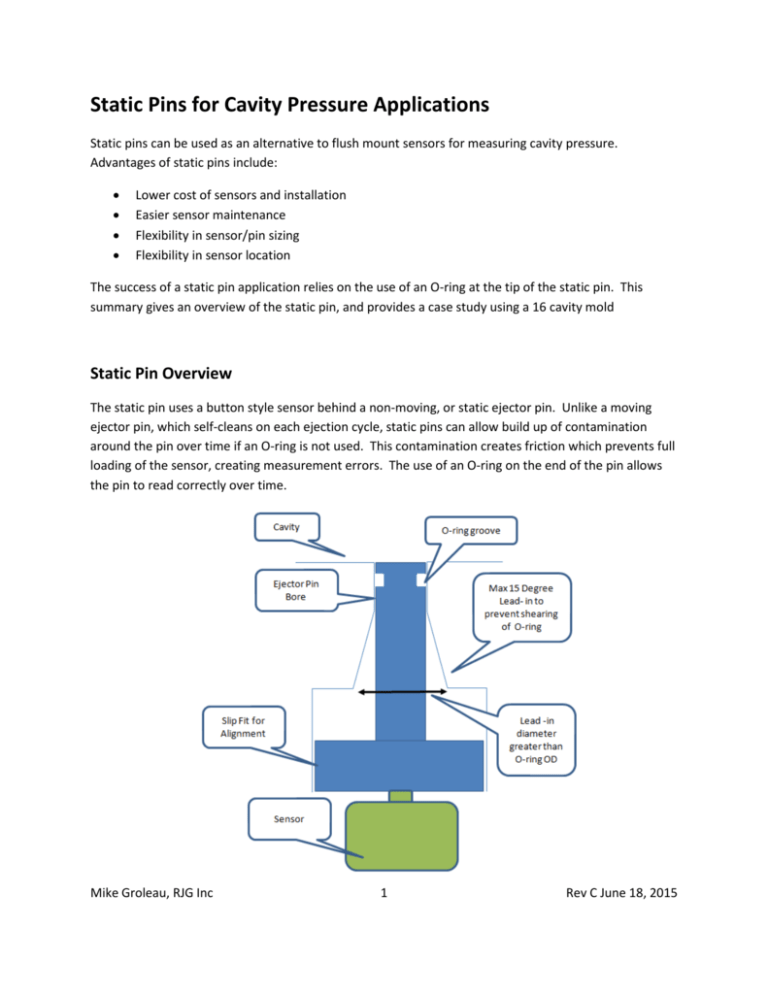
Static Pins for Cavity Pressure Applications Static pins can be used as an alternative to flush mount sensors for measuring cavity pressure. Advantages of static pins include: • • • • Lower cost of sensors and installation Easier sensor maintenance Flexibility in sensor/pin sizing Flexibility in sensor location The success of a static pin application relies on the use of an O-ring at the tip of the static pin. This summary gives an overview of the static pin, and provides a case study using a 16 cavity mold Static Pin Overview The static pin uses a button style sensor behind a non-moving, or static ejector pin. Unlike a moving ejector pin, which self-cleans on each ejection cycle, static pins can allow build up of contamination around the pin over time if an O-ring is not used. This contamination creates friction which prevents full loading of the sensor, creating measurement errors. The use of an O-ring on the end of the pin allows the pin to read correctly over time. Mike Groleau, RJG Inc 1 Rev C June 18, 2015 An O-ring is located near the tip of the pin to prevent contamination build-up. This photo shows O-rings installed on a 1/8”, 1/16” and 1 mm pin. Data from a Static Pin Application Below is data from a 16 cavity mold using 1/8” pins BEFORE O-rings were installed. Over 1 month, several of the pins became contaminated, resulting in low pressure readings. 3 Sensors Are Reading Too Low Because of Contamination Mike Groleau, RJG Inc 2 Rev C June 18, 2015 Here is the same mold AFTER installation of O-rings. The template (dashed lines) shows data collected shortly after O-ring installation. The solid lines show data after 4 months of continuous production. The sensors continue reading the same now that the O-rings are installed. All Sensors Read Accurate After Months of Operation Mike Groleau, RJG Inc 3 Rev C June 18, 2015 Keys to Successful Static Pin Application O-Ring Sizing: The O-ring is sized according to its inside diameter (ID) and cross section (CS). When ordering an O-Ring, the size is called out as the ID x CS, usually in inches. For example, a 0.072 x 0.036 O-ring would have an ID of 0.072” and a cross section of 0.036”. The O-Ring is installed in a groove, or gland, that is cut in the tip of the pin. The gland has two primary dimensions, the diameter (C) and width (G). The diameter (C) is cut to ensure that the O-Ring is stretched between 0-10%. The depth of the gland is designed so that the O-Ring is compressed around 20-35%. RJG can help with proper sizing of an O-ring for your application. Contact our support group (231-9473111, or support@rjginc.com). Give us your pin diameter (B), and we’ll give you the proper O-Ring size and gland dimensions. O-Ring Materials: In addition to the O-Ring size, the material must be specified at the time of order. The injection molding environment is harsh for O-Rings, and standard (buna-N) O-Rings will not survive. For most molding applications, a 70 durometer silicone rubber (70SLR) is preferred, and usually available in stock. For very high temperature applications and some LSR molding applications, a 75 durometer Viton (75Viton) is required. This is usually not in stock, and often requires an 8 week lead time. Sources for O-Rings: We have found that Apple Rubber (www.applerubber.com) has a very good selection of O-Rings in stock, and provides strong technical assistance. Minimum orders are usually $50 for in-stock items. Mike Groleau, RJG Inc 4 Rev C June 18, 2015 Tolerancing: The static pin should move freely in the ejector pin bore. This requires normal ejector pin tolerancing, and usually has little impact on the O-Ring function. However, for very small O-Rings (e.g. for 1 mm static pins), the tolerancing of the bore may affect the compression of the O-Ring, and additional attention to the tolerancing of the bore and the gland ID may be required. Installation of O-Rings onto the Pin: The most difficult part of the installation is getting the O-Ring onto the pin without damaging it. When improperly installed, the O-Ring can be torn as it is pulled over the sharp edge of the ejector pin. To ease installation onto the pin, a simple tool can be built using a pin of the same diameter as the ejector pin. A tapered end can be ground on the end of this pin, usually on a grinding wheel, as long as it is buffed on a wire wheel to remove any burrs that could damage the O-Ring. The sensor can be easily slid onto this tapered pin, and then slid onto the end of the static pin, as shown below. Installation Tool Mike Groleau, RJG Inc Using Tool to Install O-Ring 5 Rev C June 18, 2015 Inserting Pins with O-Rings Into the Bore With the O-Ring installed, the pin can then be inserted into the bore. An O-Ring lubricant can be used to help prevent damage. It is important to use a lubricant that does not attack the O-Ring. Many silicone based lubricants can damage silicone O-Rings. A good general purpose lubricant is P-80 THIX lubricant from International Products Corporation (http://www.ipcol.com/shopexd.asp?id=31). Samples are also available through RJG by emailing mike.groleau@rjginc.com When inserting the pin, the tapered lead-in should allow the pin to be inserted without damaging the ORing. However, it is good practice to spin the pin as it is being inserted. This will ease installation and limit the potential for O-Ring damage. Maintenance: Properly installed, the O-Ring should survive for long periods inside the mold. However there are two instances where O-Rings may need replacement: 1. Flashy materials: If material flashes around the pin, it may be necessary to pull the pin and remove the flashed material during regular PM cycles. If this is required, the O-Ring should be replaced. 2. Damage to O-Ring during PM cycles: If the pin is removed for inspection and/or cleaning during mold maintenance, the O-Ring should be inspected for damage. Over time, repeated insertion and removal can cause nicks, cuts or other damage to the O-Ring. If this occurs, the O-Ring will need to be replaced. What Questions Do You Have? We’re here to help. Contact RJG support at 231-947-3111, or email at support@rjginc.com Mike Groleau, RJG Inc 6 Rev C June 18, 2015

